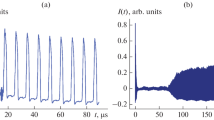Abstract
The influence of statistical gain fluctuations of the high-frequency amplifier on the sensitivity of a Dicke radiometer with selective videoamplifier is calculated with methods that are used in describing random processes. It is shown that the radiometer sensitivity depends on the power density spectrumS g (f) of the gain fluctuations for a Dicke-radiometer of the zero-balanced as well as the unbalanced type. The sensitivity of the zero-balanced radiometer is dependent onS g (f m ) wheref m is the modulation frequency. That of the strongly unbalanced radiometer depends on the product of the input temperature difference and the integral\(\int\limits_{ - \infty }^{ + \infty } {S_g \left( f \right)df} \). The sensitivity formula for the zero-balanced radiometer can be used to evaluate the power density spectrumS g (f), whereas the sensitivity formula for the unbalanced radiometer can be employed to find the value of the integral\(\int\limits_{ - \infty }^{ + \infty } {S_g \left( f \right)df} \), which governs the integral gain fluctuations.
Zusammenfassung
In dieser Arbeit wird der Einfluss statistischer Verstärkungsschwankungen des Hochfrequenzvertärkers auf die Empfindlichkeit eines Dicke-Radiometers mit selektivem Video-Verstärker berechnet. Das Resultat zeigt, dass die Radiometerempfindlichkeit vom LeistungsspektrumS g (f) der Verstärkungsschwankungen abhängt, beim null-balancierten Radiometer vonS g (f m ), wobeif m die Modulationsfrequenz bedeutet, und beim unbalancierten Radiometer vom Produkt der Differenz der Eingangstemperaturen und dem Integral\(\int\limits_{ - \infty }^{ + \infty } {S_g \left( f \right)df} \). Mit Hilfe der Formeln für die Radiometerempfindlichkeit kann das LeistungsspektrumS g (f) der Verstärkungsschwankungen des Hochfrequenzverstärkers experimentell bestimmt werden.
Similar content being viewed by others
References
R. S. Colvin,A Study of Radio-Astronomy Receivers (University Microfilms, Inc., Ann Arbor, Michigan 1962).
P. D. Strum,Considerations in High-Sensitivity Microwave Radiometry, Proc. IRE46, 43 (1958).
T. V. Seling,An Investigation of a Feedback Control System for Stabilization of Microwave Radiometers, IRE Trans. MTT, May 1962, p. 209.
W. B. Davenport, W. L. Root,Random Signals and Noise (McGraw-Hill, New York 1958).
V. Yaroshenko,Influence of the Fluctuating Factor of Amplification on the Measurements of Weak Noise-Like Signals, Radiotechnica7, 749 (1964).
W. V. T. Rusch, S. D. Slobin, C. T. Stelzried,Millimeter-Wave Radiometry for Radio Astronomy, JET Prop. Lab. Pasadena, California, USCEE Report 263, March 1968.
K. Künzi, A. Magun Z. angew. Math. Phys.22, 404 (1971), same issue as this paper.
Author information
Authors and Affiliations
Additional information
Dedicated to Professor K. P. Meyer for his 60th anniversary
Rights and permissions
About this article
Cite this article
Magun, A., Künzi, K. Influence of statistical gain fluctuations of the high-frequency amplifier on the sensitivity of a Dicke-Radiometer. Journal of Applied Mathematics and Physics (ZAMP) 22, 392–403 (1971). https://doi.org/10.1007/BF01613985
Received:
Issue Date:
DOI: https://doi.org/10.1007/BF01613985




